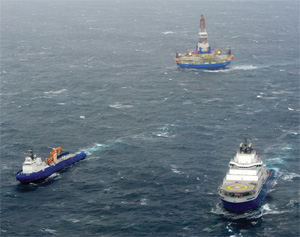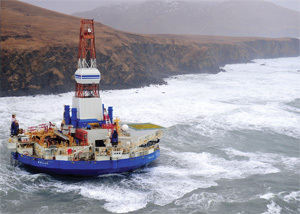A conical drilling unit ran aground near an Alaska island in December 2012 due to “inadequate assessment and management of risks” for the tow in rough winter weather, the U.S. Coast Guard said in an investigative report. The Coast Guard said three tugboat officers may have committed negligence.
The Royal Dutch Shell drill rig Kulluk broke loose from tugboats in near-hurricane conditions and ran aground along Sitkalidak Island. Four tugs took turns trying to control the wayward vessel while the area was battered by 25-foot waves and 50-knot winds.
The 360-foot icebreaking anchor-handling tug and supply vessel Aiviq initially was tasked with the job of towing Kulluk from Captains Bay, Alaska, to Seattle for maintenance work. Shell’s desire to avoid millions of dollars in state taxes that would kick in Jan. 1, 2013, “also influenced the decision” to move the 28,000-gt mobile offshore drilling unit out of Alaska in the final days of December, the Coast Guard determined.
The towing crew encountered a cascading succession of problems early in the assignment. First, all four of Aiviq ’s engines failed and the 21,776-hp tug lost its connection with the 266-foot-diameter Kulluk. Then a line fouled a propeller of a Coast Guard cutter that tried to bring the rig under control. Other respon se vessels brought Kulluk under tow again, but their connections failed or lines parted. The rig, which was now without crew because all had been evacuated, drifted until it ran aground.
The Coast Guard, which issued its investigative report in April 2014, said it found “sufficient evidence” of violations involving Aiviq operator Edison Chouest Offshore and the vessel’s master, chief engineer and third mate. Each of the three officers “may have committed an act of negligence.”
The report said the crisis began in earnest when the rough conditions caused “significant fluctuations in towline tensions” and “extreme loads” impacted the bridle configuration. The crew discovered that they had lost an apex shackle that connected the pennant wire to the triangular towing plate.
“The initiating event was the failure of the 120-ton shackle that occurred the morning of Dec. 27, 2012. However, there were numerous and compounding preconditions that created the initiating event,” the investigators wrote.
“The most significant factor (was) the inadequate assessment and management of risks associated with a complex vessel movement during the winter in the unique and challenging operating environment of Alaska,” the Coast Guard said.
The investigators said a “complete and critical assessment of the towing gear was not conducted prior to the commencement of the voyage.” A warranty surveyor who checked over the towing plan didn’t assess whether the equipment could withstand the weather conditions.
“When compared to the expected bollard pull requirements during the anticipated heavy weather, the 120-ton apex shackle was undersized,” the report said.
“The 90 feet of surge chain utilized in the length of the tow wire was insufficient and thus ineffective in achieving the desired catenary necessary to dampen shock loading encountered during the voyage,” the investigators added.
Aiviq’s power loss was caused by injector failures due to fuel contamination, probably by seawater, the investigators said. The problem was known prior to the casualty, the Coast Guard said, citing notations in engineering logs. The investigators cited design flaws including the “common vent and overflow system.” Aiviq’s master had asked the company to raise the level of fuel oil header/overflow vents, but the precaution was not taken.
The Coast Guard said Aiviq engineers did not utilize the redundant fuel management systems. They had no formal fuel-management procedures and failed to pump down the overflow tank, which was full.
 |
|
Kulluk under tow by the tugboat Nanuq, left, and supply vessel Aiviq, right, three days earlier when the flotilla encountered rough winter weather. |
|
U.S. Coast Guard |
The investigators found that Aiviq did not have the required three-watch system for the planned voyage of 1,700 nm. “The 12-hour watch system most likely contributed to fatigue among the vessel’s licensed personnel on the bridge and in the engine room,” the report said.
After the shackle failed, Aiviq reattached to Kulluk temporarily using an emergency towline, which didn’t conform to the tow plan’s specifications. The Coast Guard said it would have been preferable to connect the main towline to the towing bridle. All of the vessels were underpowered for controlling the conical rig.
“Each response vessel’s crew displayed skill and determination in an attempt to assist the Aiviq and Kulluk,” but the vessels’ “design, bollard pull and towing equipment were not sufficient for the missi on,” the report said. The original tow plan should not have relied solely on Aiviq, which had “mechanical issues and design deficiencies,” the Coast Guard said.
“The Shell towing plan(s) was not adequate for the winter towing operation crossing the Gulf of Alaska,” the investigators wrote. “The plan was not adequately reviewed, did not address the role of the Aiviq master and lacked the proper contingency planning.”
During testimony at a May 2013 hearing, Todd Case, the Noble Drilling Corp. rig manager hired by Shell to oversee Kulluk , acknowledged that Aiviq alone was not enough.
“Knowing what we know now, we know we should have had another tugboat there,” Case told the Coast Guard panel. Once the primary towline parted, “we were always slipping backward.”
The Coast Guard has not yet taken enforcement action against merchant mariners’ licenses in the incident because a broader investigation remains pending, said Petty Officer Shawn Eggert, a Coast Guard spokesman in Juneau.
“They’re in the middle of their investigation into the Aiviq — the tugboat,” Eggert said in June. “That hasn’t been completed yet. They will likely be following up with further investigation and enforcement. If they do pursue any enforcement with these individuals, it won’t be until after the investigation of the tugboat.”
The report said Edison Chouest Offshore faces a potential civil penalty for failing to report previous casualties involving Aiviq.
The accident has stymied the growth of oil exploration in the U.S. Arctic. The ice-strengthened Kulluk had been part of Shell’s multi-year plan to drill in the Beaufort and Chukchi seas. After the grounding and unrelated safety problems with other vessels, Shell postponed Arct ic exploration for 2013 and again in 2014. The company did not respond to requests for comment on the Kulluk casualty report. Edison Chouest Offshore also didn’t respond.
The Coast Guard recommends that Shell establish policies to address safe towage in its Arctic operations. The Coast Guard recommends that Edison Chouest re-evaluate safe procedures for its vessels operating in the Gulf of Alaska, including fuel oil management procedures. It suggests that Edison Chouest correct the vessel design deficiencies and train its masters in simulators.
The report recommends that the Towing Safety Advisory Committee address safety issues with the towage of mobile offshore drilling units in the Arctic. The Coast Guard may establish minimum criteria for tows in the Arctic.
“The Coast Guard reminds companies that safety and risk management need to be a priority … to ensure responsible, safe and efficient operations,” the Coast Guard wrote. “Professional mariners have a responsibility to ensure they manage and follow approved procedures for all maritime operations to prevent and mitigate potential incidents.”
Kulluk was owned by Shell Offshore Inc. and operated by Noble Drilling (US) LLC. The vessel was refloated after one week and was taken to Singapore. A heavy-lift ship carried Kulluk to a Chinese scrap yard in March 2014.

